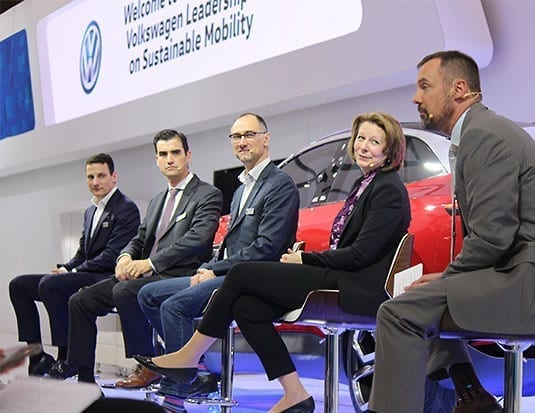Volkswagen Canada brought four innovative thought leaders together to talk about sustainable mobility at the Volkswagen Leadership Forum, as the company moves towards an emissions-free future.
The conversation was driven by commonly asked questions–taken from Google–by Canadian consumers about e-mobility, with a focus on cost, infrastructure, and environmental benefits, with experts sharing their views on the subjects. The Leadership forum included:
- Daniel Weissland, President & CEO, Volkswagen Group Canada;
- Robert Barrosa, COO, Electrify;
- Jean-François Tremblay, President & CEO, Jalon Montreal–Institute of Electrification and Intelligent Transportation Institute; and
- Yvonne Rene de Cotret, Partner, Transportation/Future of Mobility Practice Lead, Deloitte.
Cost and affordability
Cost is a concern for everyday consumers. As newer cars arrive in markets, their EV status usually means spending more money than gas vehicles. So, Canadians
have a legitimate reason to be concerned; how can EVs become more affordable for everyone?
The answer, of course, depends on a lot of different variables. For instance, the main component that makes up to 40% of the cost for electric vehicles is the battery itself, as it is four to five times more expensive than normal gas-powered engines. Another factor is the scale of production. The larger the number of cars produced, the lesser the cost. A smaller number of cars produced means a higher price. Weissland added “If you’re talking about battery-electric vehicles, it’s a pretty new technology. So, when we see more research and development, costs will come down. It’s just a question of time, and we will see that probably in the next ten years or so as we shift from fuel-combustion engine vehicles to electric vehicles.”
Barrosa goes on to say that “there’s a lot of applications that electrification can have today as we go through this transition in the cost. We’re very in tune with how that helps infrastructure. There’s a big expense to keep those stations alive and keep them operating and reliable so that consumers have the confidence to drive electric vehicles in the future.”
When purchasing a vehicle now, other variables to consider are the cost of parking, the cost of gas or charging the car, the cost of maintenance and repairs, the cost of insurance and more, all adding to the total cost of ownership. Manufacturers also have production and marketing costs, which then contribute to the overall cost of a car in the market.
Infrastructure
While cost is a big concern now, infrastructure is an on-going challenge, especially for EVs. Tremblay shares two stories with the audience. The first is about a taxi service shutting its operations down in Montreal due to their electric vehicles being 40% less efficient in the winter. The second is about his discussion with
the regional authority in India who asked for help in shortening the amount of time it took to charge their buses as six of their eight-hour commute was spent on recharging the bus.
“It’s beautiful to see that range was not an issue, they knew that, and they said lets still implement it, let’s do it, and then we’ll try to improve it,” said Tremblay. He goes on to mention how inductive charging, while expensive, needs to be readily available everywhere–for example, in hubs at street crossings–but it does need to be applied within cities.
These stories do lead to the understanding of how meaningful infrastructure is to sustainable mobility. With more and more electric vehicles on the road today, there is some concern as to whether the supporting infrastructure is in place or not. Because while electric cars are certainly sustainable, without the knowledge that charging stations are readily available, people will still be more motivated to buy gas-powered cars.
Luckily, companies are working towards incorporating those charging stations around Canada. For example, Electrified Canada’s mandate is to deploy a new network of ultra-fast charging stations to alleviate anxiety and bridge Canada’s key metro areas. They are currently installing 150kW to 350kW charging stations so that customers can get 80% of range for 30 minutes of charging on 150kW or double that on a 350kW charger for 10 to 15 minutes.
“When you think about infrastructure you think about a person who is buying a car. How they’re going to charge that electric vehicle is part of that calculation that they’re going to go through and think about,” said Barrosa. “What we’ve decided to do is bring the maximum amount of charge rate to the infrastructure possible. And what we see now is that vehicles are starting to come with that capability that will be able to accept that hard charge rate–like the e-Tron, Porsche, Volkswagen–we put the right kind of infrastructure out there and plan for the future so we can drive the right kind of experience and something that the consumer expects. We also need to build availability; we need big stations. Four stalls, six stalls or greater.”
Environmental changes
Climate change is increasingly becoming the biggest challenge of our times, and vehicles do contribute a large portion to air pollution through emissions. According to the Air Quality Health section on Government of Canada website, automobiles produce 75% of carbon monoxide and roughly one-half of pollutants like volatile organic compounds (VOCs), nitrogen oxide and particulate matter which are all dangerous to the health. Of all the cars, trucks and buses used in Canada, approximately 92% use gasoline and only 8% use diesel; however, diesel vehicles contribute to greater than 50% of some key air pollutant emissions from all on-road vehicles in Canada. In urban areas, harmful automotive emissions are worse, with between 50-90% of the air polluted by vehicles on the road today.
Hence, car manufacturers are beginning to think progressively, creating an EV and autonomous vehicle movement by upgrading their products to a battery-electric powertrain with hopes of eliminating the need for a fuel combustion engine in the future.
“It’s our responsibility to protect our planet and reduce emissions and also provide a healthy environment for our kids and grandchildren. Volkswagen wants to lead this transformation and provide emission-free mobility to everyone. We recently announced that we would invest $45 billion in the next five years to achieve this goal,” said Weissland.
So how are cities preparing to be sustainable? Cotret stated four key findings that need to be taken into consideration.
First, history is not repeating itself, and progressive cities are projecting visions as to how they will deal with people and goods moving within the city and city region to not have the economic and environmental impact that comes with congestion.
Secondly, these cities are ensuring they have the basics right. Progressive cities are making sure they are much more deliberate about plans for the future.
Thirdly, integrated mobility is essential as it is no longer about one particular mode of transportation or even about transportation at all. Integrated mobility is about the utilities, telecommunications and the technology available. Cotret says, “there is a lot of convergence across industries, and we have to start looking across all the players who have come to the table for these new modes of mobility to be adopted. Progressive cities are beginning to have these cross-industry conversations.”
And lastly, the role of private cars is going to shift and how it plays within the ecosystem over time is unknown, but progressive cities are being more deliberate in thinking about the roles they want private cars to play in the broader system itself.



